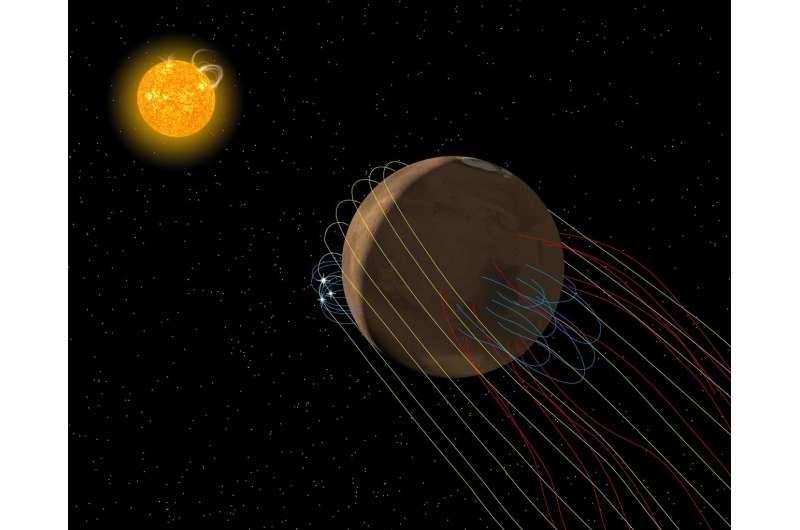MAVEN mission finds Mars has a twisted tail

Mars has an invisible magnetic "tail" that is twisted by interaction with the solar wind, according to new research using data from NASA's MAVEN spacecraft.
NASA's Mars Atmosphere and Volatile Evolution Mission (MAVEN) spacecraft is in orbit around Mars gathering data on how the Red Planet lost much of its atmosphere and water, transforming from a world that could have supported life billions of years ago into a cold and inhospitable place today. The process that creates the twisted tail could also allow some of Mars' already thin atmosphere to escape to space, according to the research team.
"We found that Mars' magnetic tail, or magnetotail, is unique in the solar system," said Gina DiBraccio of NASA's Goddard Space Flight Center in Greenbelt, Maryland. "It's not like the magnetotail found at Venus, a planet with no magnetic field of its own, nor is it like Earth's, which is surrounded by its own internally generated magnetic field. Instead, it is a hybrid between the two." DiBraccio is project scientist for MAVEN and is presenting this research at a press briefing Thursday, Oct. 19 at 12:15pm MDT during the 49th annual meeting of the American Astronomical Society's Division for Planetary Sciences in Provo, Utah.
The team found that a process called "magnetic reconnection" must have a big role in creating the Martian magnetotail because, if reconnection were occurring, it would put the twist in the tail.
"Our model predicted that magnetic reconnection will cause the Martian magnetotail to twist 45 degrees from what's expected based on the direction of the magnetic field carried by the solar wind," said DiBraccio. "When we compared those predictions to MAVEN data on the directions of the Martian and solar wind magnetic fields, they were in very good agreement."
Mars lost its global magnetic field billions of years ago and now just has remnant "fossil" magnetic fields embedded in certain regions of its surface. According to the new work, Mars' magnetotail is formed when magnetic fields carried by the solar wind join with the magnetic fields embedded in the Martian surface in a process called magnetic reconnection. The solar wind is a stream of electrically conducting gas continuously blowing from the Sun's surface into space at about one million miles (1.6 million kilometers) per hour. It carries magnetic fields from the Sun with it. If the solar wind field happens to be oriented in the opposite direction to a field in the Martian surface, the two fields join together in magnetic reconnection.
The magnetic reconnection process also might propel some of Mars' atmosphere into space. Mars' upper atmosphere has electrically charged particles (ions). Ions respond to electric and magnetic forces and flow along magnetic field lines. Since the Martian magnetotail is formed by linking surface magnetic fields to solar wind fields, ions in the Martian upper atmosphere have a pathway to space if they flow down the magnetotail. Like a stretched rubber band suddenly snapping to a new shape, magnetic reconnection also releases energy, which could actively propel ions in the Martian atmosphere down the magnetotail into space.
Since Mars has a patchwork of surface magnetic fields, scientists had suspected that the Martian magnetotail would be a complex hybrid between that of a planet with no magnetic field at all and that found behind a planet with a global magnetic field. Extensive MAVEN data on the Martian magnetic field allowed the team to be the first to confirm this. MAVEN's orbit continually changes its orientation with respect to the Sun, allowing measurements to be made covering all of the regions surrounding Mars and building up a map of the magnetotail and its interaction with the solar wind.
Magnetic fields are invisible but their direction and strength can be measured by the magnetometer instrument on MAVEN, which the team used to make the observations. They plan to examine data from other instruments on MAVEN to see if escaping particles map to the same regions where they see reconnected magnetic fields to confirm that reconnection is contributing to Martian atmospheric loss and determine how significant it is. They also will gather more magnetometer data over the next few years to see how the various surface magnetic fields affect the tail as Mars rotates. This rotation, coupled with an ever-changing solar wind magnetic field, creates an extremely dynamic Martian magnetotail. "Mars is really complicated but really interesting at the same time," said DiBraccio.
Provided by NASA's Goddard Space Flight Center



















